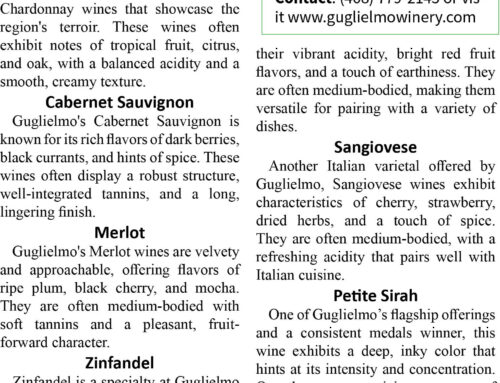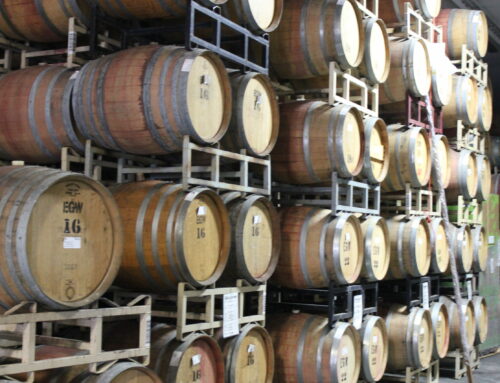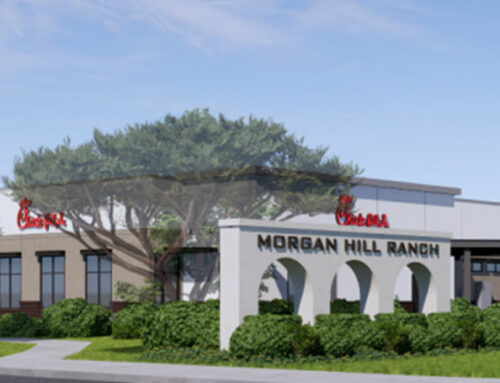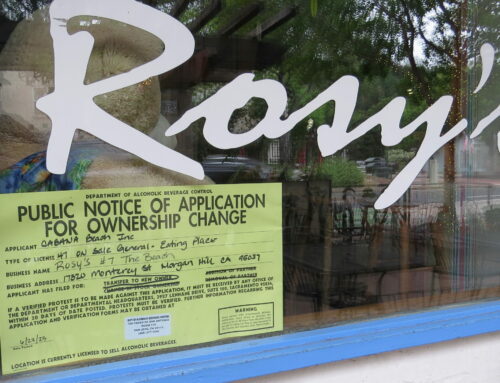Public grand opening ribbon cutting takes place at 10 a.m. Aug. 22 at Guglielmo Winery
Published in the August 20 – September 3, 2014 issue of Morgan Hill Life
By Marty Cheek

Photo by Stoney Meagher/Special to Morgan Hill Life
Jason-Stephens winemaker Jason Goelz talks to tasters in his wine production facility during a recent barrel tasting.
In comparison with Napa, Sonoma, and San Luis Obispo counties, the Santa Clara Valley region has long been California’s undiscovered wine country. That might soon change as a series of new directional signs recently installed by the county along the rural roads of Morgan Hill, San Martin and Gilroy guide visitors to nearly 30 wineries throughout one of the state’s oldest viticultural regions.
The signage program officially gets a kick-off at Morgan Hill’s Guglielmo Winery 10 a.m. Friday Aug. 22 with a ribbon cutting by dignitaries including Supervisor Mike Wasserman, the county’s Director of Asset and Economic Development Bruce Knopf, and Morgan Hill’s Principal Planner for Economic Development Edith Ramirez who all played key roles in the project. A media bus will take reporters to Morgan Hill Cellars, Thomas Kruse Winery, Fortino Winery and Kirigin Cellars to explore other long-time wineries in the area. Friday evening, local winemakers will educate community leaders on the importance of wine to the region’s economy at an invitational reception at the Morgan Hill Community and Cultural Center. The South Valley’s celebration of the Wine Trail continues Saturday and Sunday with a $40-a-ticket event similar to the popular Passport Weekend where participants receive a commemorative glass and can taste samples of vino from 16 participating local wineries.
The South Valley is steadily developing a reputation among wine connoisseurs for the quality of its vintages. The attention brought to the region by establishing a Wine Trail will help more visitors more easily find many of the family-owned wineries and thus promote wine-centered tourism, said John McKay, a member of Morgan Hill’s Tourism Alliance group involved in promoting the project. This will help wineries increasingly serve as an “economic engine” by attracting more tourists to the region, many who will also spend their leisure dollars at local restaurants and shops, he said.
“What we have now is a region of about 30 wineries that are producing great wines,” he said. “I’m not the expert, I just read about the most prestigious wine tasting competition awards in the country landing within 10 or 12 miles of where I’m sitting here in Morgan Hill. People are starting to discover local wine. It’s taking time, but remember that Napa wasn’t just discovered one day, it took decades.”
The newly established Wine Trail is a significant step toward helping visitors and locals alike understand the significance of the South Valley region as a place to enjoy premium wines, said Greg Richtarek, director of marketing at Guglielmo and president of the Wineries of Santa Clara Valley trade group.
The local wine association has spent thousands of dollars over the years in marketing the region’s wineries to help people become aware that the Santa Clara Valley is an American Viticultural Area, a federally-recognized growing region. The first vines in the region were planted by Franciscan monks in 1798, and the first commercial wine grapes were planted in the Almaden Valley in 1852.

Photo by Robert Airoldi
San Juan Bautista residents Monica Nascimento and Armand Nascimento enjoy wine poured by Stephanie Hsu, tasting room associate at Sarah’s Vineyard.
In recent years, many of the South Valley wineries have earned medals competing in blind-tasting competitions against wines from Napa, Sonoma and other more widely recognized wine regions of California, Richtarek said.
Not just the quality but the region’s wine crop value has also been steadily growing, according to reports from the Santa Clara County Department of Agriculture. In 2009, wine grapes came in at eighth place for dollar value of all agricultural crops, accounting for $6,983,000 in value. In 2013, wine grapes moved up to fifth place with a total value of $8,838,000. Last year, grapes for white wine were grown on 409 acres for a value of $2.4 million, and grapes for red wine was grown on 1,183 acres for a value of about $6.4 million.
Even though the South Valley is not recognized widely outside of the Bay Area for its wines, it is starting to see some rise in its national and even international reputation. Guglielmo’s wines are gaining a following among wine lovers in China. And its 2012 Private Reserve Pinot Grigio and 2010 Private Reserve Pinot Noir were served to President Barack Obama and other guests at a reception in May at San Jose’s Fairmont Hotel.
But still people in Silicon Valley and other parts of the Bay Area often skip the South Valley as a wine tourism destination because it doesn’t have the cachet that other regions in California enjoy.
“People don’t know we’re down here,” Richtarek said. “We’re the neglected AVA, the lost child. We’re the oldest region of premium vines in California, so we have this history about us. But we’re like Rodney Dangerfield — we get no respect.”
Part of the South Valley’s image problem is that many wine drinkers outside of the region think the wineries here are producing only jug-wine quality product much as they did for many decades following Prohibition. But during the past 10 years, there has been a concerted effort through sharing information and training among winemakers here to produce a premium quality of wine, resulting in most of the wineries winning medals in prestigious contests.
“With modern viticultural techniques that have been adopted by the different wineries, more modern opportunities and techniques of the actual wine-making process, we’ve really elevated all the wines in the region,” Richtarek said. “Just about every winery in this region makes award-winning wines now and that’s very important. So what we need to do now is change the stigma of the region from one of jug wines to one of premium wine-crafting.”
Since he joined the board of supervisors in 2010, Wasserman has made it one of his top priorities to promote the county’s agricultural heritage. That includes spreading the public recognition of the quality of South Valley wines. He considers the Wine Trail a big achievement in achieving this goal.
“Many South County residents have known for years what others will soon discover — that our award-winning wineries, most of which are family-owned, are one of our best kept secrets in the South Bay,” Wasserman said. “But it won’t be a secret for long with the new Wine Trail. I expect that we will see a steady increase in South County tourism as word spreads about our Wine Trail.”
But before the signage could be installed, the red tape had to be cut, he added. In 2012, the county’s outdated and unclear winery ordinance was overhauled based on feedback from the local wineries. The new, improved ordinance streamlines the permitting process and reduces cost to the wineries. The Wine Trail is the second major undertaking that helps promote agri-tourism in the South Valley, Wasserman said.
“In 2013, I heard from our wine community that there was a growing desire to establish a Wine Trail,” he said. “We started by identifying the obstacles, and then tackled them one-by-one…. We have so many award-winning wineries right here in our backyard, but not everyone knows about them. It’s crazy to think that Santa Clara County residents spend hours on the road driving to and from Napa Valley, spending $25 or more on tastings and fighting the crowds, when they can enjoy the same experience, or better, right here in the Santa Clara Valley.”
The Wine Trail signs will help alert people who might be traveling to more well-known destinations such as the Gilroy Premium Outlets or the Gilroy Garlic Festival who might otherwise have been unaware that the South Valley is a region full of world-class wineries, said Bev Stenehjem, who writes a wine column published in various local newspapers. To lure visitors, many of the South Valley wineries offer fun activities to do almost every weekend including live music, festivals, bocce ball and winemaker dinners, she said. Stenehjem often tells people to download a wine map online at www.santaclarawines.com as well as a free iPhone app to learn about events and newly released wines at Santa Clara Valley wineries.
“Perhaps because our wineries are mostly family owned and operated, there hasn’t been the slick advertising that other regions use,” she said. “I think our wine region may have had a sleepy start, but I see all that changing now. There’s excitement in the air about our wineries. People are discovering the short, leisurely drive to the wineries, the lack of crowds and the absolutely outstanding wines that are being poured. And they love being able to walk into one of our tasting rooms and actually meet the winemaker.”





